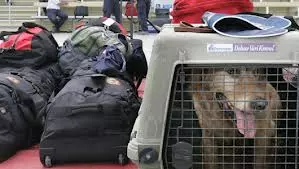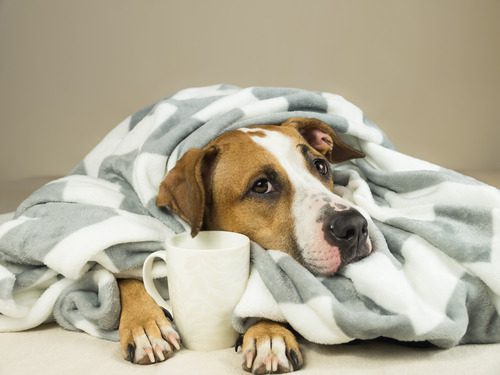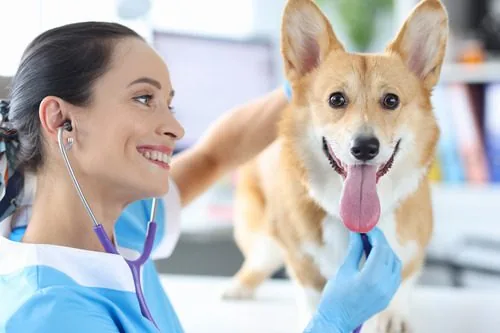Air Travel With Your Pet
 Planning a trip or vacation can be fun and exciting, but planning one in which you will be traveling by air and bringing along your dog or cat – well, that takes a quite bit more planning and preparation – and causes a lot of stress. . . particularly for your pet. If flying with your pet cannot be avoided there are several very important things you need to consider. First, and most important, safety precautions. Second, learning your airline’s rules and requirements well before your departure date. If traveling internationally – learning the varied regulations of the country you will be traveling to is an absolute must to avoid your pet being held up by customs in a foreign country or denied access and returned to the U.S. immediately upon arrival.
Planning a trip or vacation can be fun and exciting, but planning one in which you will be traveling by air and bringing along your dog or cat – well, that takes a quite bit more planning and preparation – and causes a lot of stress. . . particularly for your pet. If flying with your pet cannot be avoided there are several very important things you need to consider. First, and most important, safety precautions. Second, learning your airline’s rules and requirements well before your departure date. If traveling internationally – learning the varied regulations of the country you will be traveling to is an absolute must to avoid your pet being held up by customs in a foreign country or denied access and returned to the U.S. immediately upon arrival.
 Dr. Melissa Finke, of TVV Decatur gives us many important tips and safety precautions, along with traveling requirements and resources of information to help you and your pet’s journey be safe and uneventful…..
Dr. Melissa Finke, of TVV Decatur gives us many important tips and safety precautions, along with traveling requirements and resources of information to help you and your pet’s journey be safe and uneventful…..
The first thing to decide is whether or not it is necessary to fly with your pet. Is this a vacation or a permanent move? Could you drive to your destination? Or, could your pet stay home with a friend or stay at a boarding facility? It is always best to avoid flying with your pet whenever possible – particularly when they cannot travel in the cabin along with you. Airlines, as public record, report many injuries and deaths to pets each year. The decision to fly with your pet should not be taken lightly.
If you have no choice but to fly, then prepare early. The regulations are strict and vary significantly between airlines. As already discussed, try to fly with your pet in the cabin. Most airlines allow this for pets of a certain size and weight. If this is not an option then consider the following:
- Is my pet healthy enough to travel? The stress of flying can worsen underlying health conditions – so the option should only be open to young, healthy pets. We do not recommend sedation for pets who will be in the cargo area, as they must be able to adjust rapidly to temperature, pressure and oxygen changes.
- Are there breed restrictions? Some airlines or even destinations, do not allow certain breeds of pets. Most airlines will not allow brachycephalic (snub nosed) breeds such as pugs, bulldogs and Persians to fly due to their lack of ability to adjust well to temperature changes. Some airlines have a maximum weight allowance per animal as well.
- Consider the flight carefully. Most airlines will not allow travel during the warmest and coldest months. Try to fly nonstop whenever possible.
- Choose the right crate. There are airline regulations as to type and size of crate. Make sure to acclimate your pet early to the crate.
If flying is your decision, or flying with your pet is your only option, and you have determined that they meet all of the requirements of the airline – what about the paperwork?
For travel within the United States (except for Hawaii), most airlines require a veterinarian issued health certificate within 10 days of the flight. Again, check with your airline to confirm this. Hawaii is a rabies-free state. For this reason, it has very strict guidelines for pet importation that can be found on this website: http://hdoa.hawaii.gov/ai/aqs/animal-quarantine-information-page/ Lab tests for a rabies titer must be started at least 6 months in advance – so plan early!
For international travel, the requirements are extremely varied. Check with the embassy of the country to which you are flying, as well as the USDA for help in determining what is required. The USDA website is very helpful with your planning: http://www.aphis.usda.gov/animal_welfare/pet_travel/pet_travel.shtml.
Generally, both the airlines and the destination country will require a health certificate issued by a veterinarian within 10 days of travel and minimally, a current rabies vaccine. This health certificate may need to be stamped by the area USDA veterinarian’s office. For Georgia, the office is in Conyers and an appointment needs to be made in advance. Most countries also require a microchip (with some necessitating implantation prior to the last rabies vaccine). Not all microchips are approved for international travel so check with your veterinarian to see if your pet’s microchip is sufficient. The microchips we use at The Village Vets are approved for international travel.
Just some examples of specific country requirements:
- The United Kingdom requires a veterinarian treats for tapeworms between 24 and 120 hours of import.
- South Africa requires testing for heartworms, Leishmania, Babesia and Brucella for dogs.
- Rabies-free countries such as Japan and Australia require rabies titer testing at least 6 months in advance.
Again, consider all your options before deciding to fly with your pet and make your plans early. We are here to help so give us a call as early as possible in your planning.
Recent Posts
About The Village Vets
The Village Vets is a network of animal hospitals based in Atlanta, GA and the surrounding area. We offer honest, excellent service to our clients in a comfortable, friendly atmosphere. To learn more about our locations and how we can better serve you and your pet, click the button below.
Share This Post
Recent Posts
About The Village Vets
The Village Vets is a network of animal hospitals based in Atlanta, GA and the surrounding area. We offer honest, excellent service to our clients in a comfortable, friendly atmosphere. To learn more about our locations and how we can better serve you and your pet, click the button below.



